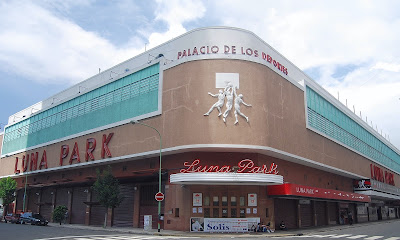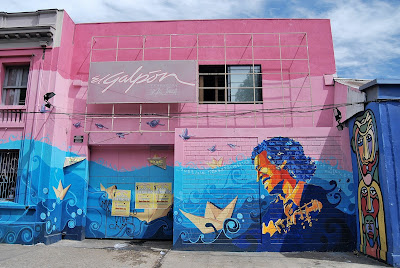In the current months of semi-quarantined torpor I have, like millions of others, spent an inordinate amount of time in front of the tube. Often my tastes run to Scandi-Noir mysteries but, over the past week, we discovered a worthwhile alternative that takes me back to Buenos Aires and elsewhere in Latin America with Rompan Todo (Break It All), a six-part documentary on rock music south of the border (despite some notable omissions, to be detailed below).
Rompan Todo focuses primarily on Mexico (Mexico City, mostly) and Argentina (primarily Buenos Aires), and evokes nostalgia not just for the distant origins of that scene, but also for the city that I can’t visit for the foreseeable future. I’m of the generation for which rock music is a touchstone, and I touched on the Argentine scene myself in a National Geographic Traveler assignment a decade ago.
In the Beginning…
The series, though, starts with the California-born Richard Steven Valenzuela—better known as Richie Valens—who energized aspiring south-of-the-border musicians with his now standard “La Bamba,” adapted from a Mexican folk song. Not so many years later, though, the influence came from across the Atlantic with the Beatles. As the series’ Argentine producer Gustavo Santaolalla notes, the earliest Argentine bands often performed cover versions in English and were often derivative—Sandro, the “Argentine Elvis,” performed Spanish-language versions of songs like Tim Hardin’s “If I Were a Carpenter.”
 |
| This tribute album to the late Sandro is a fine introduction to Mexican and South American bands. |
From the first, governments and other institutions like the Catholic Church were skeptical and often hostile toward rock. In 1971, for instance, Mexico had its own Woodstock in the unexpectedly politicized Festival de Avándaro, and Mexican officials forced rock to go underground—almost literally—for years. Argentine musicians underwent a similar experience in the approach to and aftermath of the 1976 military coup that resulted in exile for many.
 |
| Billy Bond's fans trashed the interior of Luna Park. |
One of those was Billy Bond, whose appearance in the film was a revelation–I’d never even heard of the Italian-born rocker (given name Giuliano Canterini) but, from the footage here, he seems a precursor of punk. In 1972, when he and his band La Pesada del Rock and Roll played the iconic Luna Park Stadium—an auditorium where Eva Duarte first charmed Juan Perón en route to becoming Argentina’s most powerful woman ever—Bond urged his cheap-seats fans to descend to the unsold vacancies closer to the stage, resulting in vandalism and a police round-up. Within two years, apprehensive of Argentina’s authoritarian trends, Bond left for Brazil, but continued to produce Argentine bands and, in the course of this series, he proves himself to be admirably articulate (The series, by the way, takes its name from an album by Uruguay’s Los Shakers, but “Break It All” might as well have been Bond’s motto in his youth).
Meanwhile, in Chile
 |
| Chile's coupmongers executed Víctor Jara in 1973. |
Chile underwent a similar trauma with the 1973 coup that overthrew constitutional President Salvador Allende and essentially shut down the music scene—beginning with folksinger Víctor Jara, whom Augusto Pinochet’s forces tortured and killed in an especially gruesome manner. My experience there has been more limited, though I did have the good fortune to meet, in Santiago, Claudio Parra of Los Jaivas, a group that formed in 1963 (the band name, by the way, is an adaptation of their original English “High-bass,” though it can also mean a species of crab found in Chilean waters).
 |
| Los Jaivas backstage at the Teatro Universidad de Chile (Claudio Parra is second from left) |
I had assumed the band left because of the coup, but Parra corrected me on that—as the film makes clear, they had already decided to head to Argentina for commercial reasons, and the coup merely delayed their departure. They then spent several years there and in Paris before returning to Chile, where they still tour every year. When I saw them in Santiago around the turn of the century, they struck me as a Pink Floyd comparable and, onscreen here, La Ley’s Beto Cuevas compares their Alturas de Machu Picchu (Heights of Machu Picchu, based on a poem by Pablo Neruda) to Floyd’s Live at Pompeii.
Rock Nacional, In the Post-War
My own experience with Argentina's rock nacional dates from the post-Falklands/Malvinas War period, when the dictatorship faltered (in a brief interview, the Dylanesque León Gieco ruefully admits that he and other musicians were complicit in supporting the war and, by extension, a regime they presumably loathed). After the conflict, though, they focused on songs with Spanish rather than English lyrics—Charly García, for instance, has recorded a Spanish-language version of the Byrds’ “I’ll Feel a Whole Lot Better” and once, in an under-the-railroad-tracks dive in Palermo, I heard him do “Soldado de Lata,” a similar adaptation of the Small Faces’ “Tin Soldier.”
 |
| A performance at Palermo's Roxy Live Bar (the bassist, second from right, is Charly García's bandmate Zorrito von Quintiero). |
 |
| Fito Páez performs in El Calafate. |
Other than García, the biggest names I’ve ever come close to are Soda Stereo, the first Argentine band to become a major international touring sensation, and Fito Páez, now a solo artist who also worked with García and others. I know little about Soda’s music, but I happened to be in the provincial capital of Tucumán when their publicists were passing out promotional packs of cigarettes in the central Plaza de la Independencia prior to a concert (I was not impressed). Páez I saw as part of El Calafate’s annual Festival del Lago in 2014, but the outdoor sound system was less than ideal.
Oversights and Omissions
One unspoken theme through most of the series is the scene’s overwhelmingly masculinity, but there are several prominent women, most notably Andrea Echeverri of Colombia’s Aterciopelados and Mexico’s California-born Julieta Venegas, who has worked with Santaolalla (who lives in Los Angeles). I’ll note that when I saw Charly García in Palermo, his lead guitarist was María Gabriela Epumer, who died at 39 due in part, apparently, to a medical misdiagnosis. Truly unique is Los Jaivas’ Juanita Parra (in the Chile section photo above), who replaced her father Gabriel as the group’s drummer after a fatal automobile accident. Santaolalla, though, says rock’s future is female—and, as a producer with pedigree, he’s in a position to contribute to that.
In summary, Break It All remains a worthy account of rock music south of the border (and the Equator), but with one other major omission—although it subtitles itself “The History of Rock in Latin America,” Brazil is conspicuous by its absence. I’ll confess to knowing little about its music beyond bossa nova, but a cursory glance at Wikipedia suggests that the region’s largest country has had a flourishing rock music scene ever since the mid-1950s. Perhaps Netflix should retitle the current series to represent its Spanish-language bias, and then underwrite a separate work on the history of rock em português.











